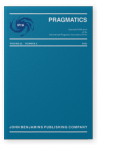Vol. 31:2 (2021) ► pp.278–302
Mi-nominalizations in Japanese Wakamono Kotoba ‘youth language’
This article explores grammatical and functional properties of mi-nominalizations in Japanese Wakamono Kotoba ‘youth language.’ In the standard variety, the suffix -mi nominalizes an adjective stem: fuka-mi ‘deep-nmlz’ (= ‘profoundness’). This suffix is also used in youth language, but its productivity has expanded considerably. To mention a few, -mi applies to not only an adjective (stem) but also a verb, a noun, a pronoun, their phrasal counterparts, and even an onomatopoeia. We claim that these properties of -mi are flexibly captured in the framework of nominalization recently proposed by Masayoshi Shibatani. This framework leads us to describe further unique properties of mi-nominalization, such as “double nominalization” where an already-nominalized form undergoes a further nominalization process and the “sentential use” of a nominalized structure where a nominalized element functions as a sentence, with which an illocutionary speech act is performed.
Article outline
- 1.Introduction
- 2.Previous studies
- 3.Framework
- 3.1Lexical nominalization
- 3.2Grammatical nominalization
- 3.3Residual issues
- 4.Analysis
- 4.1V-based nominalization
- 4.1.1Adjective (stem)
- 4.1.2Verb
- 4.2N-based nominalization
- 4.3Further issues
- 4.1V-based nominalization
- 5.Implications
- Acknowledgements
- Notes
-
References
